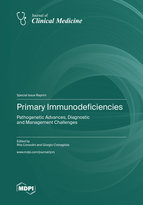Primary Immunodeficiencies: Pathogenetic Advances, Diagnostic and Management Challenges
A special issue of Journal of Clinical Medicine (ISSN 2077-0383). This special issue belongs to the section "Immunology".
Deadline for manuscript submissions: closed (25 April 2023) | Viewed by 36183
Special Issue Editors
Interests: primary immunodeficiency disorders; autoinflammatory disorders; pediatric immunology; autoimmunity; biologic drugs
Interests: inborn errors of immunity; autoimmune diseases; primary immunodeficiency disorders; immune dysregulation; autoimmune cytopenia; lymphoproliferation
Special Issues, Collections and Topics in MDPI journals
Special Issue Information
Dear Colleagues,
In the last decade, the research advances in the field of pediatric immunology brought a dramatic improvement in the diagnosis of primary immunodeficiency disorders. The use of new genetic panels allowed the identification of a considerable number of monogenic causes of primay immunodeficiency, each one featuring a peculiar clinical and immunological phenotype.
Moreover, the discovery and molecular characterization of the monogenic causes of primary immunodeficiencies helped to better understand the complex pathogenic and clinical overlap between immunodeficiency, immune dysregulation, autoimmunity and autoinflammation. The risk of lynphoproliferation and non-hematologic malignancies in children with primary immunodeficiencies has also been deeply analyzed, providing interesting information for long-term follow-up and clinical management.
Finally, the increasing knowledge on the genetic and immunological background underlying single conditions, together with the collection of data from the literature and international registries, opened up the opportunity to use targeted treatments and genetic therapy and better define the role of hematopoietic stem cell transplantaion in pediatric immunodeficiency disorders.
The present Special Issue aims to provide an update on the intriguing field of primary immunodeficiency disorders in childhood, with a particular focus on the clinical, immunological and molecular diagnostic aspects and on the most relevant improvements in the therapeutic approach to such conditions.
Dr. Rita Consolini
Dr. Giorgio Costagliola
Guest Editors
Manuscript Submission Information
Manuscripts should be submitted online at www.mdpi.com by registering and logging in to this website. Once you are registered, click here to go to the submission form. Manuscripts can be submitted until the deadline. All submissions that pass pre-check are peer-reviewed. Accepted papers will be published continuously in the journal (as soon as accepted) and will be listed together on the special issue website. Research articles, review articles as well as short communications are invited. For planned papers, a title and short abstract (about 100 words) can be sent to the Editorial Office for announcement on this website.
Submitted manuscripts should not have been published previously, nor be under consideration for publication elsewhere (except conference proceedings papers). All manuscripts are thoroughly refereed through a single-blind peer-review process. A guide for authors and other relevant information for submission of manuscripts is available on the Instructions for Authors page. Journal of Clinical Medicine is an international peer-reviewed open access semimonthly journal published by MDPI.
Please visit the Instructions for Authors page before submitting a manuscript. The Article Processing Charge (APC) for publication in this open access journal is 2600 CHF (Swiss Francs). Submitted papers should be well formatted and use good English. Authors may use MDPI's English editing service prior to publication or during author revisions.
Keywords
- new primary immunodeficiency disorders
- diagnosis of primary immunodeficiency disorders
- screening for primary immunodeficiency disorders
- immunodeficiency disorders with immune dysregulation
- immunodeficiency and autoimmunity
- immunodeficiency and autoinflammation
- new therapies for primary immunodeficiencies
- genetic therapy for primary immunodeficiency disorders
- hematopoietic stem cell transplantation for primary immunodeficiency disorders








